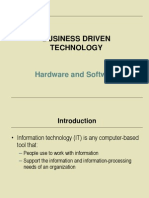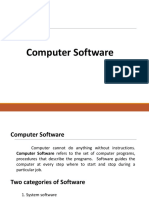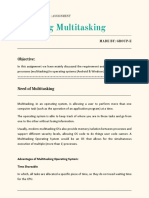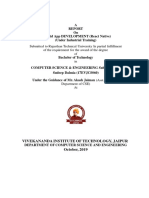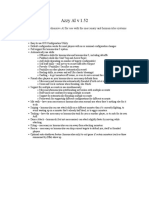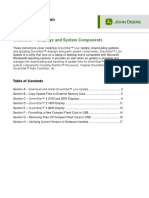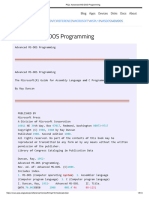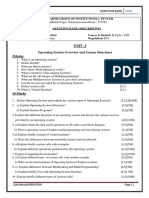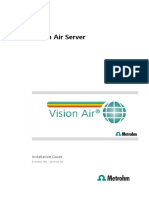)
15 . Recognize the the ethical and social impact of computer use
. Privacy Concerns: Computers enable the collection and storage of vast amounts of
personal data, raising ethical issues related to privacy and data protection
. Digital Divide: Disparities in access to technology can widen the gap between the
privileged and the underserved, creating social inequality.
. Automation and Job Displacement: The increasing automation of tasks through
computer technology can lead to job losses and economic disruption, impacting
individuals and communities.
Cybersecurity Threats: Computers are vulnerable to cyber attacks and hacking, posing
risks to individuals, organizations, and even national security.
. Intellectual Property Rights: Issues such as digital piracy and copyright infringement
raise ethical questions about the ownership and sharing of digital content.
. Dependency on Technology: Society's reliance on computers and technology can lead
to issues such as addiction, social isolation, and a decrease in face-to-face interactions.
27 with the aid of diagram explain booting process
The booting process is the sequence of events that occur when a computer is turned on or
restarted. Here is a simplified explanation of the booting process:
Power On: When you power on the computer, electricity flows through the components,
and the Basic Input/Output System (BIOS) is activated.
POST (Power-On Self Test): The BIOS conducts a series of checks to ensure that
essential hardware components like the CPU, memory, and storage devices are
functioning correctly.
Loading the Bootstrap Loader: The BIOS locates the bootstrap loader program on the
boot device (usually a hard drive or SSD) based on the boot order settings.
Loading the Operating System Kernel: The bootstrap loader loads the operating system
kernel into memory. The kernel is the core of the operating system that manages
resources and communicates with hardware.
Operating System Initialization: Once the kernel is loaded, the operating system
initializes various system components, sets up drivers, and prepares for user interaction.
� User Login: Finally, the operating system presents the user with a login screen (if
applicable)allowing users to access the system and start using applications.
Generally :This is a high-level overview of the booting process. The specific steps and
details may vary depending on the computer's hardware, firmware, and operating system.
26 . What are the advantages and disadvantage of cloud stage
Cloud storage is a service that allows you to store data on remote servers accessed through the
internet. Instead of storing files on a local hard drive or other physical storage devices, cloud
storage enables users to save and manage data on servers maintained by a third-party provider.
This data is typically stored in data centers operated by the cloud storage provider
advantages of cloud storage:
Accessibility: Cloud storage allows users to access their data from any device with an
internet connection, providing convenience and flexibility.
Cost-Effective: Cloud storage eliminates the need for physical storage devices, reducing
hardware and maintenance costs for individuals and businesses.
� Scalability: Users can easily adjust their storage capacity to accommodate changing
needs without the requirement of physical upgrades.
Data Backup and Recovery: Cloud storage offers automatic data backup and recovery
options, safeguarding against data loss due to hardware failure or other issues.
Collaboration: Cloud storage enables seamless collaboration on documents and
projects, allowing multiple users to work on shared files in real-time.
Disaster Recovery: Cloud storage serves as an off-site storage solution, ensuring data
remains secure even in the event of a physical disaster.
Disadvantages:
Security Risks: Storing data on the cloud poses security risks such as data breaches,
unauthorized access, and potential data loss.
Dependence on Internet Connection: Access to cloud storage is dependent on an
internet connection, limiting availability in offline environments.
Data Privacy Concerns: Users may have concerns about data privacy and the potential
for third-party access to their stored information.
Downtime: Cloud service outages can lead to temporary loss of access to stored data,
impacting productivity and operations.
Limited Control: Users have limited control over the physical storage infrastructure and
maintenance of cloud storage, relying on the service provider.
Subscription Costs: While cloud storage can be cost-effective in the short term, long-
term subscription costs may accumulate, especially for large storage needs.
2 . Discribe the most popular type of general purpose application
The most popular types of general-purpose applications that are commonly used across various
devices and platforms include:
Office Suites: Office suites, such as Microsoft Office, Google Workspace, and Apple
iWork, are widely used for creating documents, spreadsheets, presentations, and emails.
Web Browsers: Web browsers like Google Chrome, Mozilla Firefox, Microsoft Edge, and
Safari are essential for accessing and navigating the internet.
� . Social Media Apps: Social media platforms like Facebook, Instagram, Twitter, LinkedIn,
and Snapchat allow users to connect, share content, and interact with others online.
Messaging Apps: Messaging apps like WhatsApp, Messenger, Telegram, and Slack are
popular for instant messaging, voice calls, video calls, and file sharing.
Media Players: Media players like VLC Media Player, Windows Media Player, and iTunes
are used for playing audio and video files of various formats.
Cloud Storage Services: Cloud storage services such as Google Drive, Dropbox, iCloud,
and OneDrive enable users to store, sync, and access files across devices.
Antivirus Software: Antivirus programs such as Norton, McAfee, Avast, and Bitdefender
help protect devices from malware, viruses, and other security threats.
Photo Editing Apps: Photo editing applications like Adobe Photoshop, Lightroom, Canva,
and Snapseed are popular for editing and enhancing photos.
Generally :These general-purpose applications cater to a wide range of user needs and are
essential for everyday productivity, communication, entertainment, and creativity.
10 .Provide examples of hardware devices that handle input, processing, output, and storage
tasks
Hardware refers to the physical components of a computer or electronic device that you can
touch and see. These physical parts are tangible objects that enable a device to perform
specific functions. Hardware can include components such as the central processing unit (CPU),
memory modules, storage devices, input devices (like keyboards and mice), output devices
(such as monitors and printers), and more. Hardware interacts with software to ensure the
proper functioning of a device and allows users to perform tasks, process information, and
communicate with the system. In essence, hardware forms the foundation of a device's
structure and capabilities, serving as the tangible elements that make technology usable and
functiona
�Input Devices:
- Keyboard: Allows users to input text and commands into a computer system.
- Mouse: Enables users to navigate graphical user interfaces and interact with on-screen
elements.
- Microphone: Captures audio input for voice commands, recording, or communication.
Processing Devices:
- Central Processing Unit (CPU): Executes instructions, performs calculations, and manages
data processing tasks.
- Graphics Processing Unit (GPU): Specialized for rendering graphics, image processing, and
video playback.
- Digital Signal Processor (DSP)
: Used for processing digital signals in real-time applications like audio and video processing.
Output Devices:
- Monitor: Displays visual output in the form of text, images, videos, and graphical user
interfaces.
- Printer: Produces physical copies of digital documents, images, and other content.
- Speaker: Outputs audio signals for sound playback, notifications, and multimedia content.
Storage Devices
- Hard Disk Drive (HDD): Stores data magnetically on spinning disks for long-term storage.
- Solid-State Drive (SSD): Uses flash memory for faster data access and retrieval compared
to HDDs.
- USB Flash Drive: Portable storage device for transferring and storing data between
computers.
Generally ; though we see that hardware have got several advantage such as Hardware plays a
crucial role in the functionality and performance of computers and electronic devices. Here are
some key reasons highlighting the importance of hardware.Enabling Device Functionality,
�Processing Data and Data Storage



























